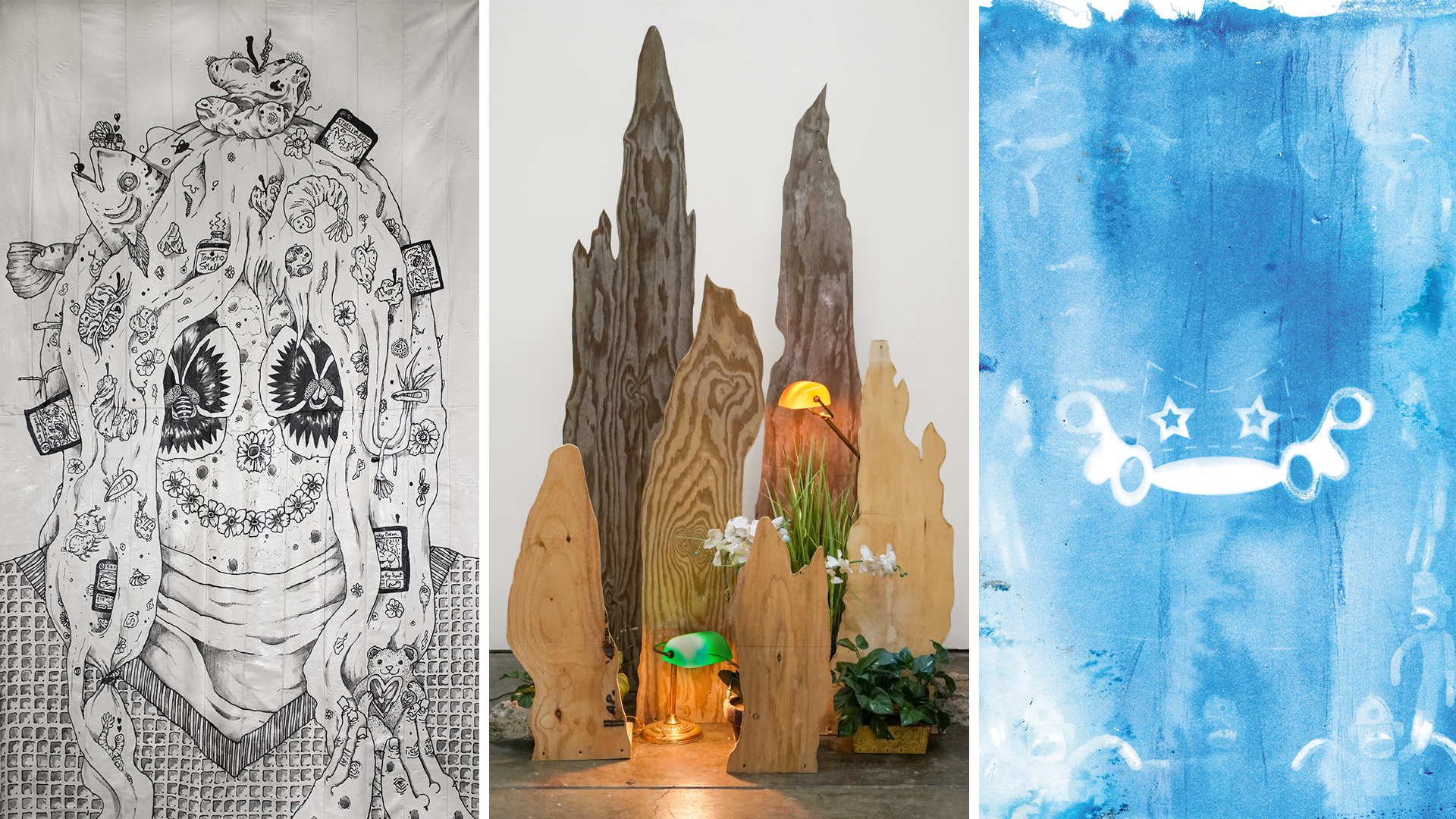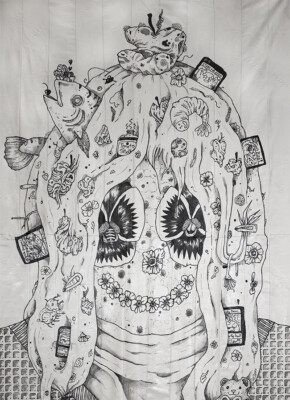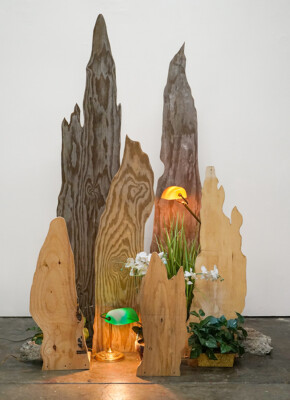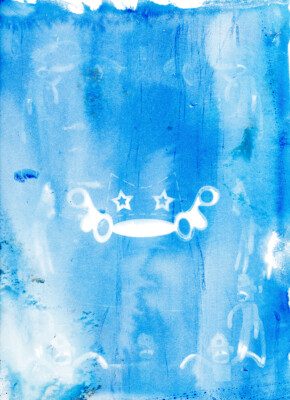
FOR IMMEDIATE RELEASE
The Artist in Residence Program at Recology San Francisco is thrilled to announce exhibition dates for current artists-in-residence Craig Calderwood, Torreya Cummings, and CCA student Qadir Parris.
Friday, January 19, 2024 from 5-8 PM
Saturday, January 20, 2024 from 12-3 PM
Tuesday, January 23, 2024 from 5-7:30 PM with artist talk by Qadir Parris at 6 PM (401 Tunnel), Torreya Cummings at 6:30 PM (503 Tunnel), and Craig Calderwood at 7 PM (503 Tunnel).
Admission is free and open to the public, no reservation required. All ages are welcome, and the site is wheelchair accessible.
Location
Recology Art Studios
503 and 401 Tunnel Avenue, San Francisco
Craig Calderwood
The Trash Oracle Sings
Written by Weston Teruya
Craig Calderwood is familiar with found and disposed things, having grown up dumpster diving and gathering discarded materials with their dad and siblings. Coming to Recology was an intentional artistic decision, shaped by those earlier experiences, informing their relationship to the sensory and material experience of the Public Reuse & Recycling Area and spending time in residence.
Through their exhibition, they ask, what if our gathered trash were a central part of our lives, if everyone shared their familiarity and collectively contended with the presence of our things? If all objects carry information about their uses, origins and endpoints, manufacturers, and consumers, what knowledge would we be confronted with on a daily basis? What songs does the Trash Oracle sing to us when it is hyper present?
In Calderwood’s paintings, iconic figures revel amidst our discards. They are of this place: bits of broken debris adorn them, some have bacterial, amorphous forms, flowers are woven across their images. The series suggests a speculative tale of intimacy with trash. Calderwood’s characters convey a joyful egalitarianism in living with the dump–there’s a beauty in having this churning receptacle for the things we don’t need, the belongings of those who we have lost–everyone’s trash finds its way here eventually. The paintings capture life amongst these ephemeral and shattered monuments to our world.
In contrast to the symbolic density of the artworks, there is a kind of stripped down sensibility to the overall installation that reflects Calderwood’s approach. Rather than returning to the pile to constantly accumulate stuff and trying to transform that hoard into more art objects, they spent a significant amount of time observing and recording the sensory textures of being amidst the pile–taking in sour smells, dusty clouds, the cacophony of machines, the crash of upended furniture, broken glass. They know what it means to seek out and live with our disposed things as material and focused on the immaterial dimensions of that experience and gathered only what they needed. Calderwood, a classically trained musician, channeled some of these sonic observations into a sound piece that also includes recorded performances with makeshift musical instruments they built from scavenged objects.
Craig Calderwood is a self-taught artist who has been living and working in San Francisco for the past 13 years. They studied printmaking and life drawing at Fresno City College for a short period of time, though they flunked out and continued their arts education through binge watching PBS art documentaries and a rigorous studio practice. They have been the recipient of the Eureka Fellowship, three San Francisco Arts Commission Individual Artist Commission grants, and recently finished the Art+Practice+Ideas Residency at Mills College. In 2024, Calderwood will be creating a mural commission for SFO’s Terminal-1 with the San Francisco Arts Commission. Calderwood has exhibited at the Oakland Museum of California (Oakland), Transpalette-Centre D’Art (Bourge, France), The Luggage Store (San Francisco), and George Adams (New York City).
Torreya Cummings
Paradise Lost & Found
Written by Weston Teruya
Imagined landscapes, particularly in the cannon of painting, have been a staple of Western colonial mythbuilding. The form neutralizes and naturalizes narratives about the world as sites to be parceled out, conquered, and stripped for resources. Fidelity to real places matters less than the ways it shapes desire and ways of looking. In Paradise Lost & Found, Torreya Cummings challenges us to consider how we see and imagine place, utilizing plastics and sculptural artifice to skew our passive consumption of visual landscapes as territory for extraction and leisure.
At the center of the exhibition, Cummings suspends a large, inverted island of densely packed artificial greenery and a menagerie of inflatable animals midair. Below the hanging sculptural mass, an irregular platform topped with an assembly of mirrors reflects the installation. Despite being turned right side up through the looking glass, like the collection above it, the image remains stubbornly out of reach, imperfect in the cobbled together surface. The disorienting doubling visualizes the landscape as more than a passive site to be claimed, the imitation jungle has a kinetic presence, looming and elusive. Inflatable palm trees, fake tropical plants, and the odd collection of fauna are enmeshed in a canopy of camouflage netting, hinting at the ways these imagined vistas have underscored long histories of imperial military expansion across the American West into the Pacific. Based on where Cummings sourced the objects in the Public Reuse and Recycling Area, they deducted that many of them had previous lives as office decor, accenting cubicles with the vibe of plastic tropics, fantasies to incentivize the workplace grind, vacations rewarding white collar labor and the corporate imagination.
In another piece, Cummings presents a rough terrain of plywood cutouts, sharp mountainous towers inspired by a postcard they scavenged of St. Jerome in a Rocky Landscape, a painting from the 1500s by Joachim Patinir that depicted an imagined Italian countryside. Like the plastic plants and animals, the components of the wooden set are abstracted approximations of nature. The scene is constructed from materials with origins marketers use to create a sense of authenticity and place–mahogany wood for dressers from Cuba and the Honduras or capiz shell coasters from the Philippines. Like the inflatable tropical plants and monkeys, these are distant echoes of the living cultures and creatures that they gesture toward. Through heightened materials, Cummings surfaces the politics and fantastic mechanisms of imaging the landscape.
Torreya Cummings is a project-based visual artist working with ideas of place and time, particularly around unlearning dominant narratives of the American West. They were a Bay Area Fellow at the Headlands Center for the Arts (2021-2023) and have exhibited solo projects at institutions including the Oakland Museum of California and Aggregate Space Gallery, and have presented performances with Machine Project, Southern Exposure, and the McEvoy Foundation for the Arts. Cummings received an M.F.A. in sculpture from California College of the Arts and lives and works in Emeryville, CA.
Qadir Parris
Spirit
Written by Weston Teruya
In Spirit, a series of new figurative paintings, Qadir Parris uses found paint, wood, textiles, and gathered ephemera to channel the energy and emotional resonance he draws from a collection of personal family photos. His portraits reach across time and geography to highlight small moments of communal joy amongst his parents, grandparents, siblings, and cousins in Miami where he grew up. Hidden away on the back side of one of his paintings, Parris wrote an exhortation to himself that summarizes the underlying ethos of the project: “ENERGY / I’ve always felt the presence of my grandfather in my work but now I feel the energy he possessed lives through me as a energy never dies / forever transferred / forever passed.” Many of Parris’s early paintings–including a couple in this exhibition–respond to his grandfather’s photographs, translated into cyanotypes that Parris paints upon; an intergenerational creative dialogue played out on canvas. This deep familial bond finds new form through materials that have similarly been re-found and taken up for use in artistic communion.
In describing the painting process while in residence, Parris notes the influence of jazz–its complex layers of improvisation and adaptation to available instruments. The longing, curiosity, joy, and pain in photographic memories finds its rhythms in the swoop of a brush stroke or the punctuation of a composite wood surface peeking through a layer of paint. Playing with found materials has granted Parris permission to utilize a newly broadened range of painterly language most appropriate to the moments being conveyed, giving the series a dynamic thrum throughout it.
Originally from Miami, Florida, Qadir Parris is a multi-faceted artist working in painting, animation, photography, film, and fashion. Through his work and creative brand /JAT/co, through which he sells his custom upcycled denim hats (JATs), Parris seeks to inspire the world. Parris is currently a student at California College of the Arts.
About the Artist in Residence Program
The Recology San Francisco Artist in Residence (AIR) Program is an art and education initiative that awards Bay Area artists access to discarded materials, an unrestricted stipend, and an individual studio space. These resources, along with comprehensive support, are provided to artists while they create a body of work and host studio visits during their four-month residency at the San Francisco Transfer Station.
Since 1990, over 150 professional artists and 50 student artists from local universities and colleges have completed residencies. Selected artists have worked across disciplines—including new media, video, painting, photography, performance, sculpture, and installation—to explore a wide range of topics.
The Recology AIR Program encourages the conservation of natural resources by providing artists with time, space, and reusable resources to create a new and impactful body of work. The Program further aims to create a more diverse and inclusive residency that amplifies perspectives from Bay Area communities and inspires children and adults who engage with the program to re-imagine their role in creating a just and sustainable world.